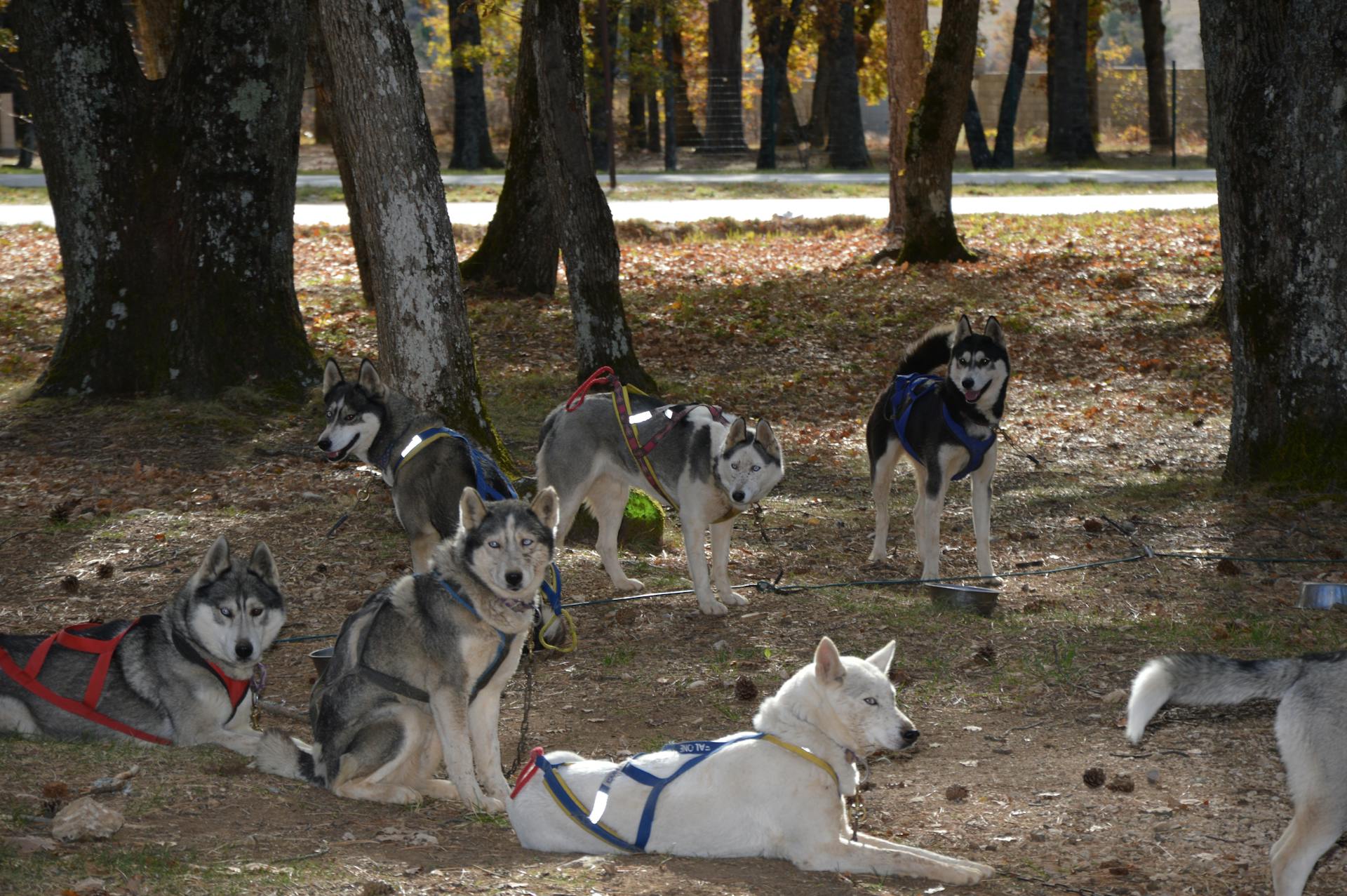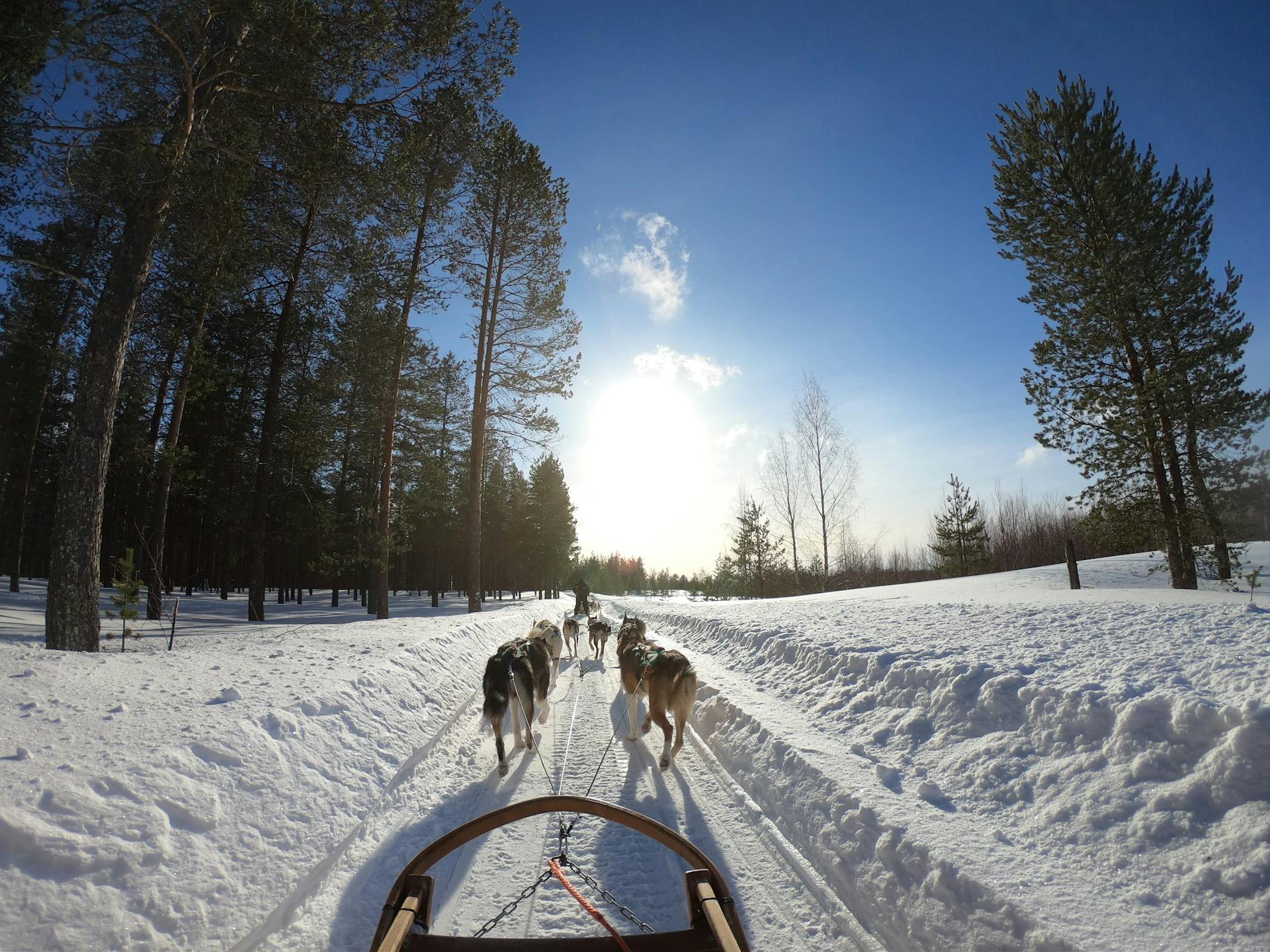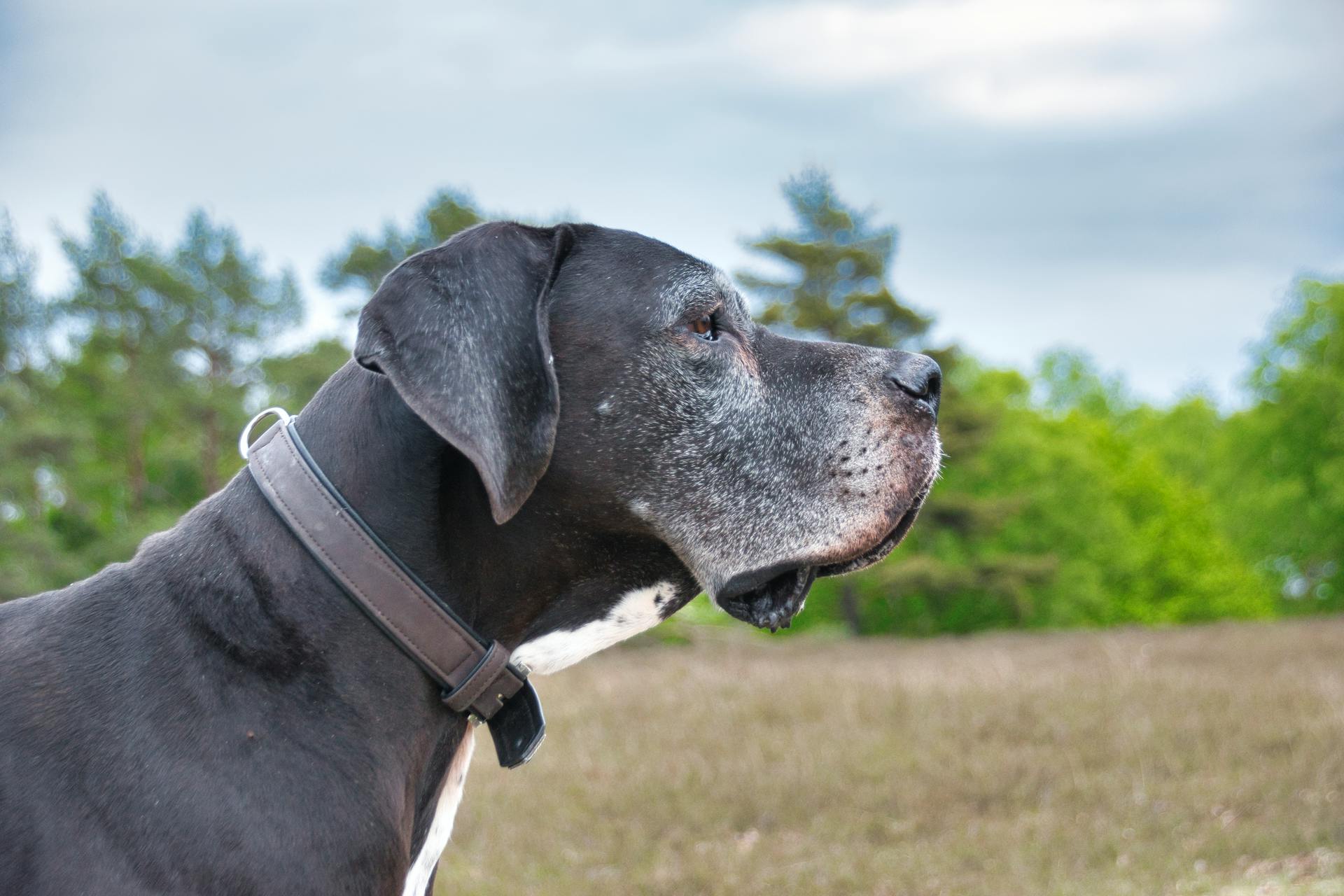
Dog sledding is a winter sport that's been around for centuries, but it's also a topic of controversy. Some people see it as a necessary part of winter tourism, while others consider it cruel to the dogs involved.
Dog sledding is a physically demanding activity for the dogs, requiring them to pull heavy loads over long distances. According to the article, a sled can weigh up to 600 pounds, which is equivalent to 4-6 times the weight of a single dog.
The dogs are typically trained to pull sleds from a young age, and they're often bred specifically for this purpose. Some breeds, like Siberian Huskies and Alaskan Malamutes, have been used for dog sledding for centuries due to their strength and endurance.
The treatment and care of the dogs is a major concern for those who oppose dog sledding. However, many dog sledding operators claim to prioritize the dogs' welfare, providing them with regular veterinary care, proper nutrition, and comfortable living conditions.
Discover more: Sled Dog Pull
Impact on Dogs
Dog sledding is a grueling activity that puts dogs through immense physical stress, with some teams running up to 100 miles a day for 7-10 days. The Iditarod, a famous commercialized dog sledding event, has seen over 140 dogs die from injuries and neglect.
Dogs used for sledding are often kept chained to their doghouse in an outdoor kennel during the off-season, with some getting only one hour of freedom per month. They're also frequently neglected, with some operators instructed to feed them as little as possible to save money.
Inadequate veterinary care is a major concern, as mushers sometimes skip checkpoints and there's no requirement for the dogs to be examined. Iditarod veterinarians have even allowed sick dogs to continue running, prioritizing the interests of the sled dog racing industry over the welfare of the dogs.
Commercialized Cruelty
The harsh reality of commercialized dog sledding is a stark one. Over 140 dogs have died in the Iditarod alone, with causes ranging from heart attacks to drowning.
The Iditarod is a grueling 1000-mile race that pushes dogs to their limits, with some teams running up to 100 miles a day for 7-10 days. Injuries are common, and dogs are often left alone at checkpoints.
In some states, commercial dog sledding practices would be considered criminally cruel, but Alaska's anti-cruelty law conveniently exempts standard dog sledding practices. This allows the industry to define what is acceptable.
During the off-season, sled dogs are often kept chained to their doghouse in an outdoor kennel, where they may be neglected or even killed when they are no longer profitable. In one case, a Colorado sled dog operator was charged with eight counts of animal cruelty after an investigation revealed starving, sick, and constantly tethered dogs left out in the cold.
In fact, cruelty charges have been filed against operators at sled dog operations all over the country, from Maine to Montana to New York.
Inherent Cruelty
The Iditarod has a dark side when it comes to the welfare of the dogs involved.
At least 136 dogs have died in the Iditarod or as a result of running in the Iditarod, according to the Sled Dog Action Coalition.
The Iditarod Trail Committee (ITC) tries to spin the harsh conditions as a necessary part of the race, but the reality is that keeping dogs outdoors for 12 days in freezing weather would be considered animal cruelty in most US states.
Iditarod rules prohibit "cruel or inhumane treatment of the dogs", but the language is vague and doesn't provide clear consequences for mushers who neglect their dogs' well-being.
If a person in another state forced their dog to run 1,100 miles through ice and snow, they'd likely be convicted of animal cruelty, but the Iditarod gets a free pass due to its exemptions in Alaskan animal cruelty statutes.
The ITC claims that some dog deaths are "unpreventable", but stopping the Iditarod would be a surefire way to prevent those deaths from happening in the first place.
Rarely Get to Run
Dogs used for sledding are often confined to a small area, tethered to a spot, and prevented from moving more than a few feet for days at a time.
This can lead to depression and neglect, as they are not given the opportunity to engage in their favorite activity - running.
They spend most of their time chained, with some dogs only getting one hour of freedom per month during the summer off-season.
This lack of exercise and freedom can have a significant impact on their physical and mental well-being.
Dogs are meant to run and play, and denying them this basic need can be detrimental to their health.
Chantal Dostaler, a former dog-sled tour operator, revealed that dogs in her kennel were treated in this way, highlighting the need for better treatment and care of these animals.
The Iditarod
The Iditarod is a highly publicized dog sled race that takes place in Alaska, but it's not just a celebration of dogs and the great outdoors. Mushers bracing for Sled Dogs' scathing indictment of the industry suggests that the Iditarod has a dark side.
The Iditarod has been criticized for putting sled dogs' lives at risk. Sled Dog Racing: Death on the Trails, a fact sheet, reveals the harsh realities of dog sled racing, where dogs can suffer from injuries, exhaustion, and even death.
Commercialized Cruelty to Sled Dogs, a 2016 article, accuses sled dog businesses of exploiting dogs for entertainment and profit.
Iditarod News
The Iditarod has been in the news for all the wrong reasons. Commercialized cruelty to sled dogs is a serious issue that has been exposed in recent years. Sled dog businesses often exploit sled dogs for profit, rather than celebrating and caring for them.
In 2016, a film was released that slammed the sled dog industry, highlighting its dark side. The film's director, Fern Levitt, even gave a radio interview to discuss the issue.
Animal cruelty charges have been brought against sled dog business owners, including one in Colorado in 2014.
Iditarod History
The Iditarod Trail was established as a route for dog sleds to access remote, snowbound areas during the 1909 Alaskan gold rush.
The Iditarod Trail Sled Dog Race was born in 1967, covering a portion of the Iditarod Trail.
The race was initially much shorter than the grueling 9-12 day event it is today.
In 1973, organizers transformed the Iditarod Race into the challenging event we know now, ending in Nome, AK.
Many people thought it was crazy to send mushers into the vast, uninhabited Alaskan wilderness.
Consider reading: Alaskan Husky Sled Dog
Animal Welfare and Activism
Animal activists are staunchly against dog sledding, and for good reason. An investigation by People for the Ethical Treatment of Animals (PETA) spied on dog sledding operations via drones and found disturbing scenes of dogs left in the cold, desperate for attention.
Some dog sledding operators tie their dogs up to posts, leaving them barely able to move more than a few feet. A former dog sled tour operator revealed that dogs were given only one hour a month off their chain during the off-season, and were often euthanized or fed as little as possible.
The treatment of dogs in dog sledding is not limited to tourist operations, but also extends to racing. Many dogs used for tourist sled rides are forced to participate in races like the Iditarod, during which over 150 dogs have died.
Animal Activists
Animal activists are a crucial part of the movement to improve animal welfare, particularly in the context of dog sledding.
They are staunchly against dog sledding, citing the mistreatment of dogs by some operators. Animal activists have been known to investigate and expose the cruel practices of dog sledding operations.
One investigation by PETA used drones to spy on dog sledding operations, revealing disturbing scenes of dogs left in the cold, desperate for attention. This kind of treatment is unacceptable and highlights the need for change.
A former dog sled tour operator revealed that dogs were given only one hour a month off their chain during the off-season, leaving them tethered to one spot for the rest of the time. This is a clear example of animal neglect.
The investigation also exposed the fact that some operators are instructed to euthanize animals and feed them as little as possible. This is a heart-wrenching reality that must be addressed.
Animal activists are not just concerned about the treatment of dogs in dog sledding, but also about the rules that allow for intentional abuse and cruelty. For example, the Iditarod rules allow mushers to whip their dogs, which is a form of intentional abuse.
The Iditarod also allows mushers to kill wild animals in defense of life or property, which is not only cruel but also unnecessary. This highlights the need for a more compassionate and sustainable approach to animal welfare.
By supporting animal activists and their efforts, we can work together to create a more just and compassionate world for all animals.
A different take: Krabloonik Dog Sledding Abuse
Changes After 2013
After the tragic death of Dorado in the 2013 Iditarod, the race organizers took some steps to improve animal welfare.
In response to Dorado's death, the organizers planned to build dog shelters at two checkpoints.
This move was a positive step towards providing a safer and more comfortable environment for the dogs.
Making a Difference
Refusing to support commercial sled dog tours and races can make a significant impact. These businesses often prioritize profits over animal welfare, treating dogs inhumanely and denying them the chance to express their natural behaviors.
The sled dog industry is a multi-billion dollar business, and it's essential to hold its sponsors accountable for their role in perpetuating animal cruelty. The Iditarod, for example, loses money on each musher and relies on corporate sponsors to stay afloat.
Boycotting sponsors of the Iditarod is a practical step towards making a difference. The Sled Dog Action Coalition has a list of sponsors that you can use as a starting point for your boycott.
The treatment of sled dogs is often hidden from public view, but it's essential to shine a light on the issue. Zack Mills, a former Krabloonik musher, described the industry as an "abomination" and compared it to a concentration camp.
Here are some ways to make a difference:
- Refuse to patronize commercial sled dog tours and races
- Boycott sponsors of the Iditarod
- Educate yourself and others about the issue
- Support organizations that advocate for animal welfare and rights
Ethics and Responsibility
Many tour operators look after their dogs very well, but separating the good from the not-so-good can be challenging.
The Iditarod, one of the most famous dog sled races in America, has been criticized by animal activists for its treatment of sled dogs. Over 150 sled dogs died during the race, but there are no official counts of how many were severely injured.
The intense competitive side of the race can push the sled dogs far beyond their endurance or capabilities, with racers and their sled dog teams often experiencing inclement weather during the race.
Take a look at this: Dog Breeds That Are Good with Other Dogs
The Mushers
The mushers are fully aware of the risks involved in the race, making them the ones who voluntarily decide to participate. They know what they're getting themselves into.
Mushers can choose to drop out and walk away when the race becomes too difficult. This freedom to make decisions is not available to the dogs.
Individual dogs are dropped from the team when they become sick, injured, or dead, highlighting the harsh consequences for them.
Take a look at this: What Can You Feed Dogs Instead of Dog Food
Ethical?
The Iditarod dog sled race has been a topic of debate for many years, with some questioning its ethics. Over 150 sled dogs have died during the race, with no official counts of severe injuries.
Animal welfare concerns are a major issue in the Iditarod. The intense competitive side of the race can push sled dogs beyond their endurance or capabilities.
The harsh weather conditions during the race, including blizzards, sub-zero temperatures, and extreme winds, can be particularly challenging for the dogs. This is not even enough to stop the race.
The Iditarod has lost some corporate sponsorships due to concerns about animal cruelty. Wells Fargo stopped sponsoring the race in 2017, and Exxon pulled its financial support after the 2021 race.
The pressure from PETA and other animal rights organizations has likely contributed to the loss of corporate sponsorships.
Finding an Ethical Company
Finding an Ethical Company is crucial when it comes to dog sledding. Many tour operators look after their dogs very well, but it's up to you to do your research.

To start, look for companies that prioritize their dogs' welfare. They often have transparent policies and practices that ensure the dogs are treated with respect and care.
Research the company's history and reputation. If they have a good track record, it's likely they're doing something right.
Some companies even offer behind-the-scenes tours or meet-and-greets with the dogs, which can give you a glimpse into their treatment and living conditions.
It's also essential to ask questions and get answers. A reputable company will be happy to share information about their dogs' care, training, and living arrangements.
Making a Difference
Refusing to support commercial sled dog tours and races can make a significant impact. This industry is an abomination, as described by a former musher.
Dogs need to be loved, respected, and treated well, and given the chance to express their full range of behaviors. Just letting dogs be dogs can help prevent inhumane treatment.
The Iditarod, a well-known sled dog race, loses money on each musher, and relies on corporate sponsors for funding. Urge the sponsors to stop supporting animal cruelty.
A former Iditarod trainer views sled dogs as nothing more than tools, highlighting the lack of regard for their welfare. Dogs are not tools, but living beings that deserve respect and care.
Boycotting sponsors of the Iditarod can help bring attention to the issue of animal cruelty in the industry. The Sled Dog Action Coalition has a list of sponsors that can be used to take action.
Here are some ways to make a difference:
- Boycott sponsors of the Iditarod and other sled dog races
- Refuse to patronize commercial sled dog tours and races
- Support organizations that work to protect sled dogs and prevent animal cruelty
By taking these steps, you can help bring attention to the issue of animal cruelty in the sled dog industry and make a difference in the lives of these amazing animals.
Frequently Asked Questions
Do dogs love dog sledding?
Dogs bred for dog sledding, such as Siberian Huskies and Alaskan Malamutes, are naturally suited for the activity and often thrive on it. Their innate traits make dog sledding a joyful experience for these canine athletes.
Sources
- https://aldf.org/article/commercialized-cruelty-to-sled-dogs/
- https://www.peta.org/blog/peta-watch-dogs-in-distress/
- https://www.dogster.com/lifestyle/is-dog-sledding-cruel
- https://humanedecisions.com/sled-dogs-exposing-the-cruel-and-inhumane-truth-behind-the-sled-dog-industry/
- https://www.treehugger.com/iditarod-trail-sled-dog-race-and-animal-cruelty-127645
Featured Images: pexels.com


